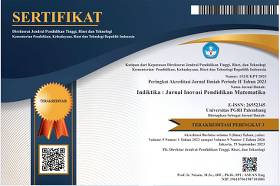Systematic Literature Review: Penerapan Teknologi Virtual Reality dalam Meningkatkan Pengalaman Belajar
DOI:
https://doi.org/10.31851/indiktika.v7i1.15182Keywords:
systematic literature review, virtual realityAbstract
Penelitian ini bertujuan melakukan Systematic Literature Review (SLR) terkait pemanfaatan Virtual Reality (VR) sebagai media pembelajaran untuk meningkatkan pengalaman belajar siswa. Metode SLR Kitchenham & Charters digunakan dalam tiga tahap: Planning, Conducting, dan Reporting. Dari review 15 artikel jurnal di Scopus, VR diterapkan di kesehatan dan pendidikan (SMP, SMA, Pendidikan tinggi). Pengukuran menggunakan kuesioner, observasi, dan wawancara. Kontribusinya meliputi peningkatan pengalaman belajar, terapi pasien, dan pengetahuan siswa. Penelitian mendukung VR sebagai penyokong belajar dan terapi, namun perlu penelitian lanjutan untuk dampak jangka panjang. Hasil review menunjukkan bahwa penerapan VR secara signifikan meningkatkan pengalaman belajar siswa dalam berbagai tingkatan pendidikan, sekaligus memberikan manfaat pada bidang kesehatan seperti terapi pasien. Namun, belum ada penelitian yang mengukur dampak jangka panjang dari penggunaan VR dalam konteks pembelajaran. Oleh karena itu, penelitian lanjutan yang fokus pada evaluasi dampak jangka panjang terhadap perkembangan pengetahuan, keterampilan, dan aspek mental siswa sangat diperlukan.
References
DAFTAR PUSTAKA
Acha, A. R. de la T. (2024). Application of simulation and virtual reality to production learning. Education and Training.
Azher, S. (2023). Virtual Simulation in Nursing Education: Headset Virtual Reality and Screen-based Virtual Simulation Offer A Comparable Experience. Clinical Simulation in Nursing, 79, 61–74.
Bachiller, C. (2023). Augmented and Virtual Reality to Enhance the Didactical Experience of Technological Heritage Museums. Applied Sciences (Switzerland), 13(6).
Betts, K. (2023). An Examination of the Effects of Virtual Reality Training on Spatial Visualization and Transfer of Learning. Brain Sciences, 13(6).
Billingsley, G. (2019). A Systematic Literature Review of Using Immersive Virtual Reality Technology in Teacher Education. Journal of Interactive Learning Research, 30(1), 65–90.
Calvert, J. (2023). Improving Student Learning Outcomes Using Narrative Virtual Reality as Pre-Training. Virtual Reality, 27(3), 2633–2648.
Chunhong, Z. (2024). Application of Virtual Reality Technology in Second Language Classroom Teaching in Colleges and Universities. Journal of Intelligent and Fuzzy Systems, 46(1), 711–722.
Cowan, P. (2023). Using Virtual Reality to Support Retrieval Practice in Blended Learning: An Interdisciplinary Professional Development Collaboration between Novice and Expert Teachers. Digital, 3(3), 251–272.
Hamilton, D. (2021). Immersive Virtual Reality as a Pedagogical Tool in Education: A Systematic Literature Review of Quantitative Learning Outcomes and Experimental Design. Journal of Computers in Education, 8(1), 1–32.
Kisi, K. P. (2024). Creating a Construction Safety VR Game with Decision-Making Scenarios for an Interactive Learning Experience. Computing in Civil Engineering 2023: Resilience, Safety, and Sustainability - Selected Papers from the ASCE International Conference on Computing in Civil Engineering 2023, pp. 452–460.
Kitchenham, B & Charters, S. (2007). Guidelines for Performing Systematic Literature Reviews in Software Engineering. Technical Report, Ver. 2.3 EBSE Technical Report. EBSE, 1(January 2007), 1–54.
Lau, J. S. Y. (2024). Development and Usability Testing of Virtual Reality (VR)-Based Reminiscence Therapy for People with Dementia. Information Systems Frontiers.
Naz, Z. (2024). Development and evaluation of immersive VR laboratories of organic chemistry and physics for students education. Physica Scripta, 99(5).
Pears, M. (2023). A Pilot Study Evaluating a Virtual Reality-Based Nontechnical Skills Training Application for Urology Trainees: Usability, Acceptability, and Impact. Journal of Surgical Education, 80(12), 1836–1842.
Pramesti, A. A., Sitompul, R. P., Sopiya, N., & Fitroh. (2022). Systematic Literature Review: Pemanfaatan Virtual Reality (Vr) Sebagai Alternatif Media Pembelajaran. Jurnal Pendidikan Teknologi Dan Kejuruan, 19(2), 105–117.
Rojas-Sánchez, M. A. (2023). Systematic Literature Review and Bibliometric Analysis on Virtual Reality and Education. Education and Information Technologies, 28(1), 155–192.
Ummihusna, A. (2024). Immersive Virtual Reality in Experiential Learning for Architecture Design Education: An action research. Journal of Applied Research in Higher Education.
Ummihusna, A., & Zairul, M. (2022). Investigating Immersive Learning Technology Intervention in Architecture Education: A systematic literature review. … of Applied Research in Higher Education.
Wang, C. Y. (2023). Enhancing Anatomy Education Through Cooperative Learning: Harnessing Virtual Reality for Effective Gross Anatomy Learning. Journal of Microbiology and Biology Education, 24(3).
Wang, H. (2023). Analysis of Learning Behaviour in Immersive Virtual Reality. Journal of Intelligent and Fuzzy Systems, 45(4), 5927–5938.
Wu, H. (2023). Using Deep Learning and Virtual Reality to Build an Animation Game for the Healthcare Education. Journal of Mechanics in Medicine and Biology, 23(4).
Yu, Z. (2023). A Meta-Analysis of the Effect of Virtual Reality Technology Use in Education. Interactive Learning Environments.
Yuan, J. (2023). Educational Metaverse: An exploration and practice of VR wisdom teaching model in Chinese Open University English course. Interactive Technology and Smart Education, 20(3), 403–421.
Zhang, X. (2024). Examination of the Use of VR Combined with Internet Technology to Enhance the Experience of Sound Art in the Treatment of Anxiety Disorders. Journal of Internet Technology, 25(1), 15–25.
Downloads
Published
Issue
Section
License
Copyright (c) 2024 Ni Wayan Suardiati Putri Putri, Ketut Agustini, Gede Rasben Dantes, I Gde Wawan Sudatha

This work is licensed under a Creative Commons Attribution-ShareAlike 4.0 International License.
This work is licensed under a Creative Commons Attribution-ShareAlike 4.0 International License.
Authors who publish with this journal agree to the following terms:
- Authors retain copyright and grant the journal right of first publication with the work simultaneously licensed under a Creative Commons Attribution License that allows others to share the work with an acknowledgement of the work's authorship and initial publication in this journal.
- Authors are able to enter into separate, additional contractual arrangements for the non-exclusive distribution of the journal's published version of the work (e.g., post it to an institutional repository or publish it in a book), with an acknowledgement of its initial publication in this journal.
- Authors are permitted and encouraged to post their work online (e.g., in institutional repositories or on their website) prior to and during the submission process, as it can lead to productive exchanges, as well as earlier and greater citation of published work.












